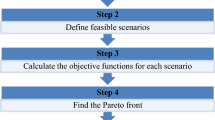Abstract
In this paper, the concept of the Shortest-Route Traffic Matrix(SRTM) was first presented, and the generalized formula for computing ring capacity requirement in use of SRTM is given. Then, a new capacity design algorithm which is based on SRTM was presented for Synchronous Digital Hierarchical(SDH) Bi-directional Self-Healing Ring (BSHR). The algorithm simulation results demonstrate that this algorithm is very efficient for SDH BSHR capacity design and can make less project investment and make high utilization of lines and equipment. By means of the algorithm in this paper, capacity optimization assignment for SDH Hierarchical Self-Healing Ring (HSHR) and for ATM Virtual Path (VP)-based Self-Healing Ring (SHR) is also discussed.
Similar content being viewed by others
References
T. H. Wu, M. Burrowes, Feasibility study of a high-speed SONET self-healing ring architecture in future interoffice fiber networks, IEEE Communications Magazine, 28(1990)11, 33–42.
T. Flanagan, Fiber network survivability, IEEE Communications Magazine, 28(1990)6, 46–53.
J. Sosnosky, T. H. Wu, SONET ring applications for survivable fiber loop networks, IEEE Communications Magazine, 29(1991)6, 51–58.
T. H. Wu, R. C. Lau, A Class of self-healing ring architectures for SONET network applications IEEE GLOBECOM’90, San Diego, CA: December 1990, 403.2.1–403.2.8.
J. Sosnosky, T. H. Wu, Definitions of ring architecture, ANSI T1X1.5/90-179, September 1990.
B. E. Smith, C. Yackle, SONET bidirectional ring capacity analysis: A pragmatic view. ICC’94, Singapore: May, 1994, 489–493.
Y. Okanoue, et al., Design and control issues of integrated self-healing networks in SONET GLOBECOM’91, Florida: Dec. 1991, 22.1.1–22.1.6.
T. H. Wu, Fiber Network Service Survivability. New York: Art-House, 1992, 439–441.
Long Keping, Chen Jilu, Huang Xiangfu, New methodology and algorithm to planning new SDH transmission networks in China, ISTST’96, Kunming: September, 1996, 49–55.
J. Shi, J. P. Fonseka, Dimensioning of self-healing rings: Single rings and their interconnections, GLOBECOM’93, San Francisco: Dec. 1993, 43.3.1–43.3.5.
Author information
Authors and Affiliations
Additional information
Supported by Key Project for the Ninth Five-Years Programming of Ministry of Posts and Telecommunications of China
About this article
Cite this article
Long, K., Cheng, S., Liu, H. et al. A new synchronous digital hierarchical Bi-directional ring capacity design algorithm based on the shortest-route traffic matrix. J. of Electron.(China) 16, 123–129 (1999). https://doi.org/10.1007/s11767-999-1032-0
Issue Date:
DOI: https://doi.org/10.1007/s11767-999-1032-0




